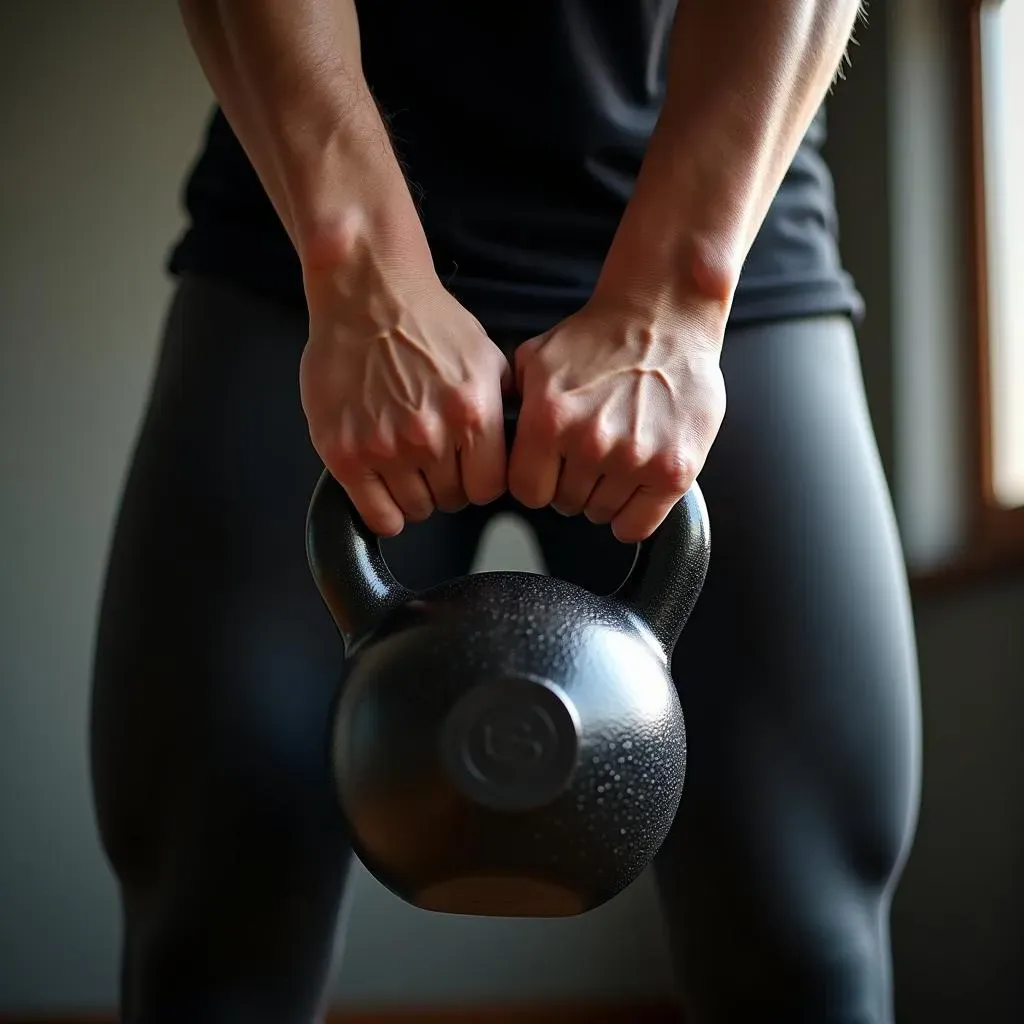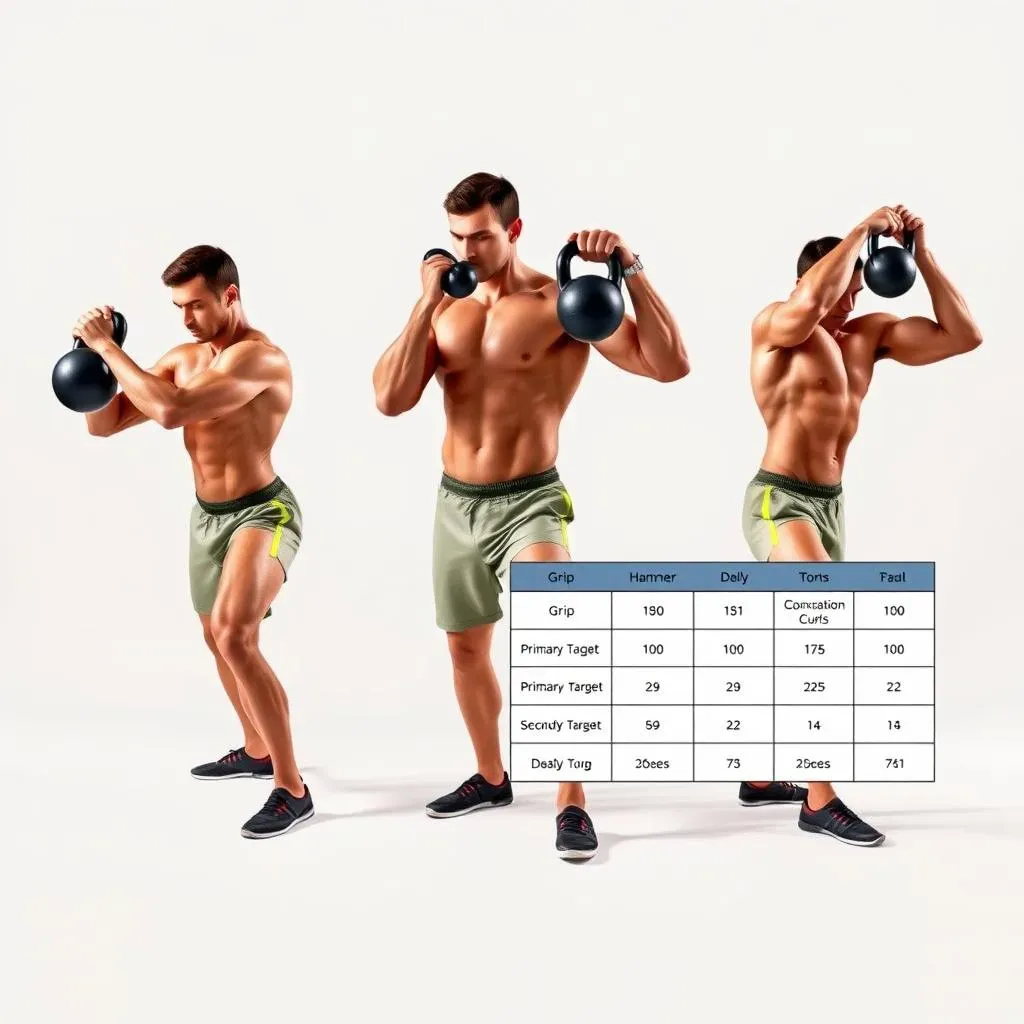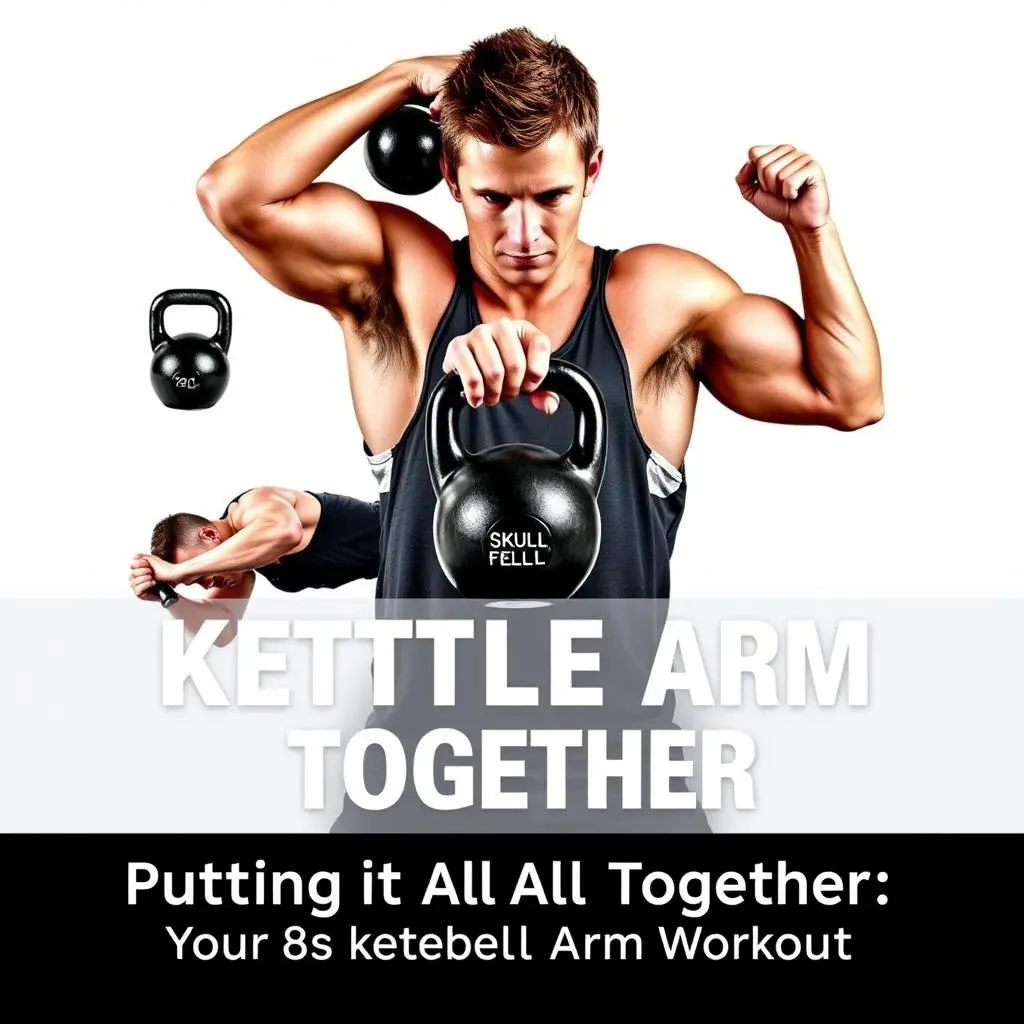Table of Contents
Ever feel like your arms could use a bit more 'oomph'? You're not alone. Many people chase stronger arms, and the secret weapon might just be sitting in your gym corner: the kettlebell. Forget those endless bicep curls with dumbbells; kettlebells are about to change your game. We're not just talking about building show muscles; we're talking about real, functional strength that helps you in everyday life. This isn't your average workout guide, it's a journey into the world of kettlebells, focusing on the best arm workouts with kettlebell. We'll start with the basics, so you understand why this funny-looking weight is so effective. Then we'll target those biceps and triceps with specific exercises, showing you how to get the most out of each movement. Finally, we'll piece it all together into a workout routine, so you can start seeing results. Ready to swing into action? Let's go!
Kettlebell Basics: More Than Just a Weight

Kettlebell Basics: More Than Just a Weight
What's the Big Deal with Kettlebells?
Okay, so you've seen those cannonball-looking things with handles, right? That's a kettlebell, and it's way more than just a weird dumbbell. Unlike dumbbells that isolate muscles, kettlebells are all about movement. They train your body to work as a unit, engaging multiple muscle groups at once. Think of it like this: instead of just flexing your bicep, you're swinging, squatting, and pressing – all while building arm strength. It's like getting a full-body workout while focusing on your arms.
And this is the key difference. Kettlebells aren't about isolating a muscle. They're about movements and flow. When you do a kettlebell swing, it's not just your arms that are working. Your core, your legs, your back—everything's involved. It's a whole-body party and your arms are definitely invited. This makes kettlebell training super efficient. You get more bang for your buck, and you're building useful strength for everyday life.
Kettlebell vs. Dumbbell: A Quick Showdown
So, why pick a kettlebell over a dumbbell? Well, they both have their place but kettlebells offer unique advantages. Dumbbells are great for specific muscle targeting – like those bicep curls you're probably familiar with. But kettlebells, with their offset center of gravity, challenge your stability and coordination way more. They force your body to work harder to control the weight, which translates to greater strength gains.
It’s like comparing a race car to a monster truck: both are vehicles, but they’re built for different things. Dumbbells are the race cars, precise and focused. Kettlebells are the monster trucks, ready to rumble and engage everything. This difference is key for understanding why kettlebells are so effective for building functional arm strength. They're not just about lifting; they're about moving.
Feature | Kettlebell | Dumbbell |
|---|---|---|
Weight Distribution | Offset, below the handle | Evenly distributed |
Focus | Full-body movement, functional strength | Muscle isolation |
Stability Challenge | High | Lower |
Best For | Swings, cleans, dynamic movements | Curls, presses, isolated exercises |
Top Kettlebell Exercises for Biceps

Top Kettlebell Exercises for Biceps
Kettlebell Bicep Curls
Alright, let's talk biceps. You might think, "Curls, easy peasy!" But kettlebell curls are a different beast. Instead of just lifting the weight straight up, the kettlebell's shape forces you to stabilize the weight more. This means more muscles are engaged, and you're getting a more effective bicep workout. Hold the kettlebell by its handle, let it hang down, and then curl it up, keeping your elbows tucked close to your body. The key is to control the movement, both on the way up and on the way down. No swinging, unless you want to make it harder.
I remember the first time I tried these, I thought I was a bicep curling champ, but the kettlebell humbled me quick. The offset weight made it feel like the kettlebell was trying to escape my grasp. But that's the beauty of it, it engages your forearms and grip more than a typical dumbbell curl, making it a more complete exercise.
Kettlebell Hammer Curls
Next up, we have hammer curls. This variation targets your biceps and forearms, giving you a more rounded, powerful look. Instead of curling the kettlebell with your palms facing up, you'll hold it with your palms facing each other, like you're holding a hammer. Then, curl the weight up, keeping your elbows close to your body, just like with regular curls. This subtle change makes a big difference in muscle activation.
I find that hammer curls are great for building grip strength too. When you are holding the kettlebell in that hammer position, you're really working the muscles in your forearms. It's a great exercise to add to your routine if you're looking for more than just bicep gains. It's like a two-for-one deal, and who doesn't love a good deal?
Exercise | Grip | Primary Target | Secondary Target |
|---|---|---|---|
Kettlebell Bicep Curl | Palms Up | Biceps | Forearms |
Kettlebell Hammer Curl | Palms Facing Each Other | Biceps, Brachialis | Forearms, Grip |
Kettlebell Concentration Curls
Now, if you want to really zero in on those biceps, concentration curls are your friend. Sit down, place your elbow on the inside of your thigh, and let the kettlebell hang down. Curl it up slowly, focusing on squeezing your bicep at the top of the movement. The controlled movement, and the stability provided by your arm resting on your thigh, helps you isolate the bicep muscle, making this a great addition to the other exercises.
When I do these, I can literally feel the bicep working, it's a completely different feeling compared to standing curls. Concentration curls are like the sniper rifle of bicep exercises, precise and effective. They're not about lifting the heaviest weight, but rather about feeling the muscle work. It's a great way to finish off a bicep workout, giving you that satisfying pump.
Kettlebell Tricep Power Moves

Kettlebell Tricep Power Moves
Kettlebell Overhead Extensions
Okay, so we've hit the biceps, now it's time for the triceps, the back of your arm. A great exercise is the kettlebell overhead extension. Grab that kettlebell with both hands, lift it overhead, and then bend your elbows, lowering the weight behind your head. The key is to keep your elbows pointing straight up, not flaring out to the sides. This exercise is like a mini-workout for your triceps. You can do this standing or sitting, and it really targets the long head of the tricep, which is the part that gives your arms that nice horseshoe shape.
I have to admit, the first time I did these, I felt like I was about to drop the kettlebell on my head. It takes some coordination and control, but the burn is real. It's one of those exercises that might feel a bit awkward at first, but once you get the hang of it, you'll start feeling those triceps working like never before. Don't be afraid to start with a lighter weight until you get the movement down.
Kettlebell Skull Crushers
Next up, let's talk skull crushers, which sounds way more intimidating than it is. Lie down on your back, hold the kettlebell with both hands, and extend your arms straight up. Then, bend your elbows, lowering the weight towards your forehead. The name might be scary, but the exercise is all about controlled movement. Keep your elbows tucked in and focus on using your triceps to lift the weight back up.
I remember the first time I tried these, I was so focused on not hitting myself in the head that I forgot to engage my triceps properly. It's a great exercise for really isolating the triceps, and you can feel it working on the entire muscle. If you're looking to build some serious tricep strength, skull crushers are a must-have in your routine, just make sure you have control of the weight.
Exercise | Starting Position | Movement | Target |
|---|---|---|---|
Kettlebell Overhead Extension | Standing or Sitting, kettlebell overhead | Bend elbows, lower weight behind head | Triceps (long head) |
Kettlebell Skull Crusher | Lying down, arms extended up | Bend elbows, lower weight towards forehead | Triceps (all heads) |
Kettlebell Close-Grip Push-Ups
Now, let's get a little creative with push-ups. Place your hands on the kettlebell handles, or on the bell itself if you're feeling adventurous, in a push-up position. Lower your chest towards the ground, keeping your elbows tucked close to your body, then push back up. The close grip forces your triceps to work harder than a standard push-up. It's a great way to add some intensity to your push-up routine without needing any extra equipment.
I've found that these are a great way to mix up my usual push-up routine. The instability of the kettlebell really challenges your core and stabilizer muscles too. It's like a full-body exercise disguised as a simple push-up. If you're looking for a way to make your push-ups more challenging and engaging, give these a try.
Putting it All Together: Your Best Kettlebell Arm Workout

Putting it All Together: Your Best Kettlebell Arm Workout
Designing Your Kettlebell Arm Routine
Okay, so we've covered a bunch of exercises. Now, how do we put them all together into a workout? The key is to create a balanced routine that hits all parts of your arms, and remember, we're not just going for a pump, we want functional strength. Think of it like building a house: you need a strong foundation (the basics), sturdy walls (your biceps and triceps work), and a solid roof (the overall fitness). You want a mix of exercises that focus on both biceps and triceps, and you also want to incorporate some compound movements, which means exercises that work multiple muscles at once.
When I first started, I tried to do every exercise every workout, and it was a disaster. I was sore and overtrained, and I learned that less is more. Start with a few exercises and focus on mastering those before adding more. It's not about how much you do, it's about how well you do it. Always listen to your body and don't be afraid to take a rest day when you need it.
Sample Kettlebell Arm Workout
Here’s a sample routine to get you started. Remember, this is just a suggestion. Feel free to adjust it to your fitness level and goals. It's like a recipe; you can always tweak it to your taste. You can do this workout 2-3 times a week, with a rest day in between. For each exercise, aim for 3 sets of 8-12 repetitions. If you're new to this, start with a lighter weight and focus on form. As you get stronger, you can increase the weight.
I like to start with a warm-up, maybe some light cardio and arm circles, to get the blood flowing. It's like preparing your car for a long drive; you need to warm up the engine before you hit the road. The workout should be challenging, but not so hard that you're struggling to finish each set with proper form. Remember, consistency is key; it's better to do a little bit regularly than to go all out once in a while and then give up.
Exercise | Sets | Reps |
|---|---|---|
Kettlebell Bicep Curls | 3 | 8-12 |
Kettlebell Hammer Curls | 3 | 8-12 |
Kettlebell Overhead Extensions | 3 | 8-12 |
Kettlebell Skull Crushers | 3 | 8-12 |
Kettlebell Close-Grip Push-Ups | 3 | As many as possible with good form |
Tips for Kettlebell Arm Training
A few key things to keep in mind. Firstly, form over everything. It's better to use a lighter weight with proper form than a heavy weight with bad form. Bad form can lead to injuries, and nobody wants that. Secondly, don't be afraid to experiment. Try different exercises, different rep ranges, and see what works best for you. It’s like being a chef; you need to try different combinations to create something amazing. Thirdly, be patient. Results don't happen overnight. It takes time and consistency to build strength.
And lastly, have fun! Working out shouldn’t be a chore. Find exercises you enjoy and make it a part of your lifestyle. When you enjoy what you're doing, you're more likely to stick with it. I know it sounds cheesy, but it's true. So grab that kettlebell, get moving, and unleash your arm strength. You've got this!